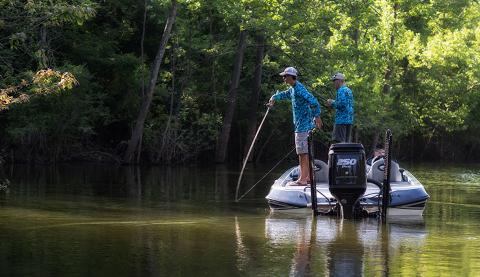Since 1998, Mossy Oak ProStaffer Clint Lindemann of Enderlin, North Dakota, has bowhunted with a crossbow, which at the time seemed to be an impossible dream for him. When Lindemann was 15, he was paralyzed from his neck down in a hunting accident. You can follow Clint Lindemann at www.facebook.com/clint.lindemann.
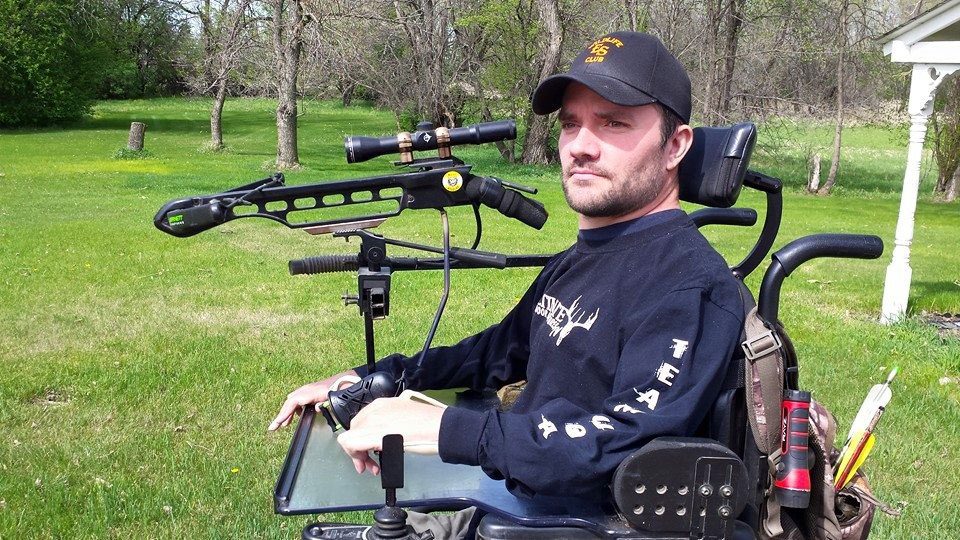
When I was 15, I was bowhunting in a river bottom close to home. One of my 14-year-old friends was walking up the river bottom to try and push a deer towards me and my other friend. The driver had a .22 rifle that he was planning to use to hunt squirrels and rabbits as he walked up the bottom. I guess he mistook me for a squirrel, and I was just in the wrong place at the wrong time. When he fired his rifle, the bullet hit my C4 and C5 vertebrae. When my friend reached me, he was terrified and extremely upset. My other hunting buddy was my age (15) and he saw what happened, ran to the vehicle and called for an ambulance. I was in the hospital for 3 months.
After being shot, I couldn’t feel any pain, which was both good news and bad news. About a month after I was shot, the doctors told me, “There’s no way you’ll ever be able to walk again.” At that time and being that young, I didn’t realize that for the rest of my life I’d have to depend on other people to do most everything for me. But I did learn to do almost everything I wanted to do, including starting back hunting again. I wrongly assumed that my love of hunting was gone forever. I didn’t see how hunting, for me, would ever be possible again. I knew I’d have to replace hunting with something else, so I became an assistant baseball coach for boys 13-14 years old, when I was 18.
Back to Hunting
While I was coaching, our team went to the state finals twice. When I got the call from the man at “Twist of Fate,” and he asked me to come hunt with him, I told him, “I can’t hunt, but I’d like to come down and watch.”
He replied, “We’re going to get you out there hunting.”
In my mind, and I didn’t speak it, I thought this guy was crazy, or else he didn’t know I was a paraplegic. I thought that there was no way he understood that I physically couldn’t hunt. However, once we arrived at the hunt, (my Dad went with me), the folks there gave me a crossbow. My dad rigged it up, so I could shoot it. When I started participating in the hunt, I saw people there who had much worse disabilities than mine, who were hunting and harvesting deer! I was also surprised that people from all over the country who had disabilities were coming to this hunt.
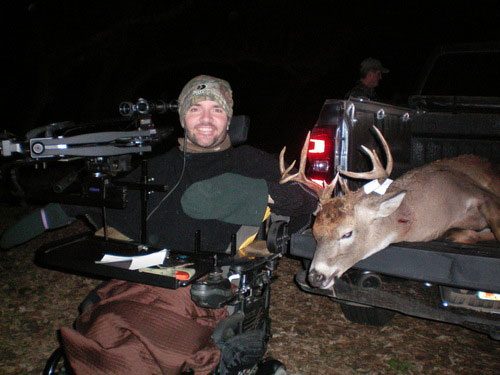 “Twist of Fate” takes 12 hunters with disabilities on this hunt, and they’ve had people from Florida and all over the nation come and participate. I guess the most amazing hunter I saw on that first hunt was a guy who was blind. He’d figured out how to shoot a bow accurately, even though he couldn’t see. Once I saw that the disabled could hunt and take deer with crossbows, I decided that there was no reason that I couldn’t pick up my love of hunting and get back into the outdoors that I loved so much. I drew a lot of confidence from the people I came to know at the “Twist of Fate” hunt.
“Twist of Fate” takes 12 hunters with disabilities on this hunt, and they’ve had people from Florida and all over the nation come and participate. I guess the most amazing hunter I saw on that first hunt was a guy who was blind. He’d figured out how to shoot a bow accurately, even though he couldn’t see. Once I saw that the disabled could hunt and take deer with crossbows, I decided that there was no reason that I couldn’t pick up my love of hunting and get back into the outdoors that I loved so much. I drew a lot of confidence from the people I came to know at the “Twist of Fate” hunt.
That hunt with “Twist of Fate” was more than a hunting trip. I met and camped with other hunters with disabilities and saw how they hunted, and how enthusiastic they were about hunting. They explained to me how and why being paralyzed shouldn’t stop me from hunting. Hunting was my passion all my life, and from the day I could no longer hunt, I felt a real sense of loss. On this hunt not only was I able to go hunting, but I learned from people who were like me, and who hadn’t stopped hunting because they had disabilities. From the other hunters there, I learned that I could travel and hunt anywhere in the country that I wanted to go; and those people turned on the light for me to show that just because I had a disability, I shouldn’t let my disability prevent me from hunting.
I didn’t take a deer on that hunt, but what I got from that hunt was more valuable and far more important than if I’d taken a monster buck. Since that first deer hunt, I’ve bear hunted in Minnesota and antelope hunted in Wyoming. I haven’t taken a bear yet, but I was able to take an antelope with my rifle in 2013; and I have taken 10 bucks and 4 does.
Hunting in North Dakota
I deer hunt every season in North Dakota. Each year before bow season arrives, I scout for the deer I want to take. I primarily hunt private lands around Enderlin, North Dakota, my hometown. I hunt for shelter rows of trees that have been created to break the wind and snow we have in our area in the winter. These shelter belts are often from a 1/2-mile to a mile long. I also hunt the Maple River bottom and the Sheyenne River bottom in North Dakota.
I hunt from a ground blind, /our-obsession/blogs/deer/ground-blind-tips and once I find a location I want to hunt, my friends and family clear out shooting lanes for me. I have a new pickup truck that I can get my wheelchair in on the passenger side, so either my friends or my family will drive me out to my blind, help me out of the truck, then move the truck so deer can’t see it. I use a Primos Hunting ground blind, and I can usually hunt okay in cold temperatures down to 40 degrees. Then I have a heater I put in my blind. In 2008 and 2009, we had two hard winters back to back and a good number of our deer died off. But from the pictures I’m getting on trail cameras, the deer herd has rebounded; and I believe we’re going to have a good deer season this year. So far this season, I’ve found a buck that will probably score in the 130s.
By the time bow season arrives in late August/early September, I hope to have four or five stand sites set up so I can hunt. I feel fortunate that I have friends and family who will take me out to hunt any time I want to go. I usually don’t hunt in the mornings, because I make so much noise getting out of the truck and into my stand that I’m concerned I’ll spook the deer. So, most of my hunting is in the afternoons – usually 3 to 4 hours before sunset. In North Dakota, we can hunt deer until a half hour after sunset.
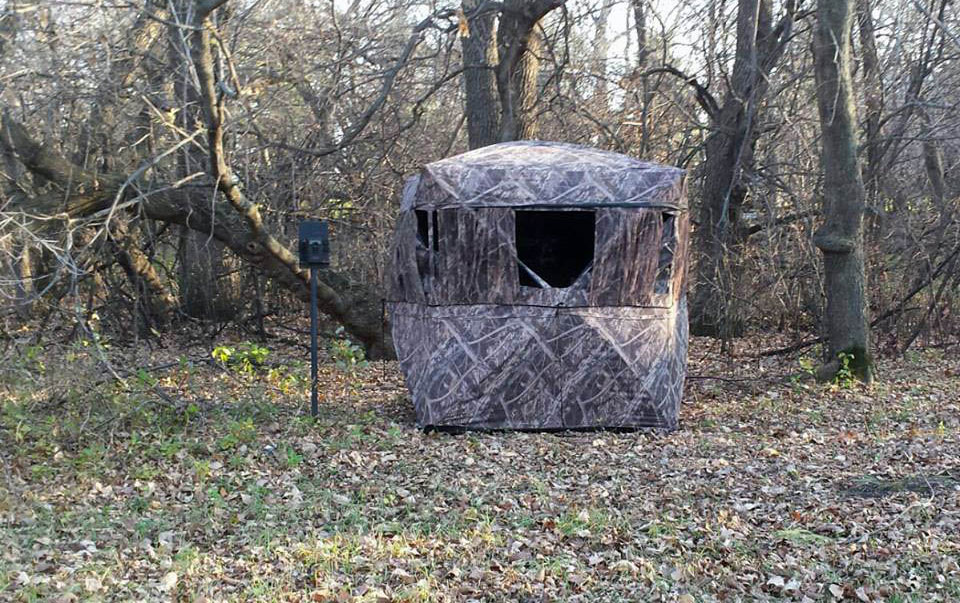
Retrieving a Deer in a Wheelchair
I’m often asked “How do you recover your deer when you arrow one?” I usually wait for 1/2-hour after I arrow a deer, and then I call one of my friends or family members to come out and help me trail him. If we don’t have a good blood trail, I may wait until the next morning before I start looking for the deer. The exception to that rule is, if I can hear coyotes howling, I’ll go after my deer earlier. Since we have a lot of coyotes in North Dakota, I have to make sure I get to my deer before the coyotes find him.
I shoot a Carbon Express Intercept Crossbow with a Muzzy broadhead. I practice and shoot accurately out to 50 yards, but I try and keep the shots I take at deer at 30 yards or less. We have legal baiting here in North Dakota, so I’ll oftentimes put out bait and/or deer lure to try and get the deer to come closer. I use Buck Bomb as a deer lure and a cover scent.
Most Memorable Hunts
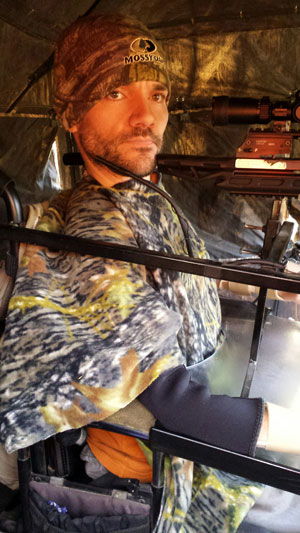 I hunt at least 20 days during bow season and sometimes more. I took my best buck in 2013 - a 7x5. When I saw that deer coming toward my blind, I could tell he had double-split brow tines. He only scored 112 inches, but he was a trophy for me. I’ve got a shoulder mount of him on my wall. I hunted that buck during the rut and was able to grunt him in with my grunt tube.
I hunt at least 20 days during bow season and sometimes more. I took my best buck in 2013 - a 7x5. When I saw that deer coming toward my blind, I could tell he had double-split brow tines. He only scored 112 inches, but he was a trophy for me. I’ve got a shoulder mount of him on my wall. I hunted that buck during the rut and was able to grunt him in with my grunt tube.
Because I can’t use my hands very well, I have an electronic device that makes the sounds of bucks fighting. So, most of the time I just use the grunt tube. The grunt tube I have has a long rubber tube on the front of it, and I have it taped to the bottom of my crossbow with black electrical tape. Then I can grunt at the same time I’m aiming at a deer. I can get my crossbow in position to shoot by using my chin. I also use my chin to raise, lower or move my crossbow to the left or the right, so I can aim my scope at the spot I want to hit on the deer. My crossbow is mounted onto my wheelchair.
On my toughest hunt, I didn’t harvest a deer. I’d seen this buck a couple of times and decided he was the deer I wanted to take. I hunted for that buck 32 different afternoons. Although I saw him four or five times while I was out hunting, the buck never came close enough to me for me to take a shot. I think he would have scored around 140 on Pope &Young (P&Y).
Although I really enjoy bowhunting, I also rifle hunt for deer, and I also have modified my rifle to mount on my wheelchair. I shoot a Remington .243, and I’ve taken two buck whitetails and one antelope with my rifle. Each year I sight my rifle in, and I practice shooting out to 300 yards.
My longest shot was 250 yards. We had found a lot of bucks while scouting, but we couldn’t get permission to hunt on the land where we’d located the bucks. We were coming back home from hunting and about two miles from home spotted a buck. At that time, I had a van, and I had a permit to shoot from the van. When we spotted that buck out in the CRP field where we had permission to hunt, we opened the side of the van. I pivoted toward the deer, got my rifle up to my mount and finally got squared away to take the shot. I was kind of nervous about the first shot, but the buck didn’t move. I might have had a small dose of buck fever. On my second shot, as I was getting prepared to shoot, I thought I had probably jerked the trigger with the first shot. I began to concentrate on squeezing the trigger for my second shot and that shot hit the buck square in the shoulder. He dropped right where he’d been standing. That buck would probably score about 110 inches on P&Y. He was a 4x5 and I was really proud to have taken him.
Greater Appreciation for Hunting
I like being out in the woods alone and by myself. I like having the ability to find a place to hunt and then be able to choose the hunting site where I want to hunt. I like the freedom of being able to choose what animal I want to try and take. I like to take the shot by myself, not have someone else take it for me. I just like hunting and fishing and now I can do that.
I don’t guess I really realized how much I loved being outdoors in the woods and on the water, until I lost my ability to participate in those sports. So, when I had the opportunity to not only get back to hunting with both a bow and a rifle, I appreciated it much more. I wanted to go more than I’d ever gone before. I see now that there are many more opportunities for people with disabilities to be able to hunt, fish and get in the outdoors than there ever has been in the past.
Clint Lindemann is not the only disabled hunter who found his way in the outdoors. Ashlee Lundvall, also a member of the Mossy Oak ProStaff, redefined her life to participate in the outdoors after a fall left her paralyzed.
















